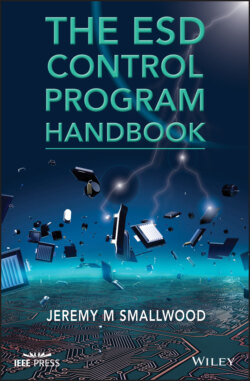Читать книгу The ESD Control Program Handbook - Jeremy M. Smallwood - Страница 75
2.8.2 Neutralization of Surface Voltages by Air Ions
ОглавлениеClean air is naturally a good insulator with very few mobile charged particles present. A small number of ions are naturally generated when air molecules are split into positive and negative ions by the action of natural radioactivity or cosmic rays (Jonassen 2016a). These ions will be repelled or attracted by surface charges due to the electrostatic field. The ions move in the direction of the electrostatic field.
The charge migration rate and direction are dependent on the ion charge and other factors, as well as the electrostatic field strength and direction at the point in space where the ion is located. In still air, the ion drift velocity vd is related to electrostatic field E by the ion mobility μ.
The mobility of the ion is dependent on the ion size. In air, charges bind to water, nitrogen, and other molecules or particles and form small or large ions. Small ions have mobility in the range 1−2 × 10−4 m2 V−1 s−1 (Jonassen 2016a). Large ions have mobility in the range 8 × 10−7 to 3 × 10−8 m2 V−1 s−1.
The number of air ions present can be increased using an ionizer. These produce air ions by various means such as corona discharge, radioactive, or X‐ray ionization of the air. Radioactive and X‐ray ionization sources provide both polarity ions by splitting air molecules into positive and negative ions.
Corona discharge sources use a high voltage applied to a sharp electrode (e.g. needle) to produce ions of one polarity. A nearly balanced ion source can be produced by this method by using an alternating current (AC) high voltage or two separate sources of opposite polarity.
A charged surface produces an electrostatic field surrounding it that repels like polarity ions and attracts opposite polarity ions. That is, a negatively charged surface repels negative ions and attracts positive ions. A positively charged surface attracts negative ions and repels positive ions. Opposite polarity ions will drift to the charged surface at a rate proportional to the field strength and in numbers proportional to the ion concentration. An opposite polarity charge on reaching the charged surface neutralizes an equal charge, reducing the net surface charge and electrostatic field. The ion drift represents a neutralizing current, limited by the ion concentration and field strength.
